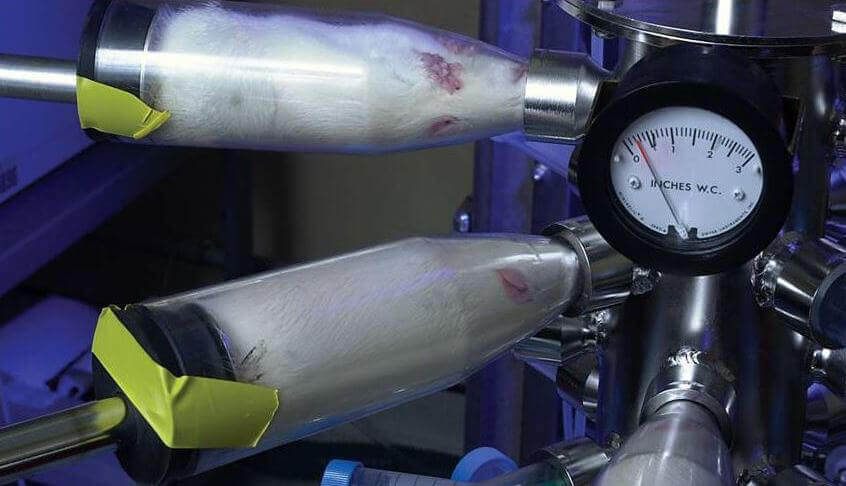Did you know that regulatory agencies worldwide require tests to assess the effects of certain chemicals, drugs, and other substances on human lungs before these products can be marketed or sold? In these tests, rats are squeezed into narrow tubes and forced to inhale toxic substances for hours on end.
Rats are squeezed into inhalation tubes.
Inhalation toxicity tests kill an estimated 1 million animals each year.
But a new paper authored by PETA Science Consortium International e.V., the U.S. Environmental Protection Agency, and other collaborators will help change that. It shows how the respiratory tracts of humans and rats differ and how these differences impact the ability of toxicity tests on rats to reliably predict the effects in humans.
Humans breathe through the nose and mouth, whereas rats breathe only through the nose. Humans have bigger noses and can inhale bigger particles than rats, whose noses are smaller and more complex because smell is one of their most important senses. A human’s airway is vertical since we’re two-legged, whereas a rat’s is horizontal.
These and other differences are highlighted in the new peer-reviewed publication coauthored by the Science Consortium.
The paper—published in Regulatory Toxicology and Pharmacology—examines how key differences between the respiratory tracts of humans and rats can limit the ability of inhalation tests on rats to predict what will happen when humans inhale a substance and showcases the opportunity to use non-animal tests instead.
Ending the use of animals in inhalation toxicity tests is a major area of focus for the Science Consortium.
Last year, the Science Consortium coauthored and helped fund a breakthrough study showing that frozen human lung slices work as well as fresh ones to assess the toxicity of inhaled chemicals, expanding the availability of these tissues for research and helping to replace the use of animals in these tests.
Another paper coauthored and funded by the Science Consortium shows how non-animal, cell-based methods can be used to predict the health effects of inhaled chemicals.
To help ensure that researchers have the tools they need to replace animal testing with modern, animal-free methods, the Science Consortium awards researchers tissues and equipment and helped fund the development of a first-of-its-kind 3-D model of the lower respiratory tract, all of which can replace the use of animals in inhalation toxicity tests and better predict what happens when humans inhale chemicals.
With Every Donation, PETA Scientists Help Prevent Animals From Being Used in Chemical Tests
For more than 10 years, the Science Consortium has collaborated with government agencies, academia, contract research organizations, and companies to replace tests on animals with human-relevant, non-animal methods.
The post Differences in Human and Rat Anatomy Should Stop Inhalation Testing on Animals in Its ‘Tracts’ appeared first on PETA.

